National Symbols of Wales
1.
National Flag
2.
National Anthem
3.
National Day
4.
The Welsh Language
5.
The
Welsh Music
6.
The Leek and the
Daffodil
National Flag
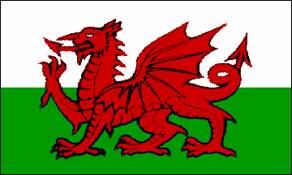
…has two equal horizontal stripes, white above
green, and a large red dragon. In the Historia Brittonum (ascribed to Nennius)
of around 800 A.D. the dragon is seen as a symbol of national independence in
the story of the red dragon battling with the white dragon of the Saxon
enemy. Despite its occasional use by other figures famous in Welsh history, the
red dragon became the symbol of the Welsh nation through its adoption by the
Tudor ancestors of king Henry VII. Edmund and Jasper Tudor had a dragon as crest
and supporter to the arms granted them by Henry VI. When Henry Tudor faced king
Richard III at the battle of Bosworth in 1485 his battle standards numbered
three. One of these carried the arms of St. George of England, one the arms of
the house of Beaufort and on one was a "Red ffyry dragon peyntid upon white and
Grene Sarcenet". It is held that this dragon banner represented Henry
Tudor's claim to be a true representative of the ancient kings of Britain and
served as his tribute to the Welsh people who had made his victory possible.
National Anthem
 Words by EVAN JAMES (1809-1893)
Words by EVAN JAMES (1809-1893)
Music by JAMES JAMES
(1833-1902)
First sung in 1858
Land of my Father
The land of my fathers is dear unto me,
Old land where the minstrels are honoured and free;
Its warring defenders so gallant and brave,
For freedom their life's blood they gave.
CHORUS
Home, home, true am I to home,
While seas secure the land so pure,
O may the old language endure.
Old land of the mountains, the
Eden of bards,
Each gorge and each valley a loveliness guards;
Through love of my country, charmed voices will be
Its streams, and its rivers, to me.
CHORUS
Though foemen have trampled my land 'neath their feet,
The language of
Cambria still knows no retreat;
The muse is not vanquished by traitor's fell hand,
Nor silenced the harp of my land.
CHORUS
National Day
 St.
David’s Day (1 March) is the national day of Wales. St. David (cc. 520-588), the
patron saint of Wales, was the founder and first abbot-bishop of Menevia, now
St. David’s in Dyfed, South Wales.
St.
David’s Day (1 March) is the national day of Wales. St. David (cc. 520-588), the
patron saint of Wales, was the founder and first abbot-bishop of Menevia, now
St. David’s in Dyfed, South Wales.
A poll conducted for Saint David's Day in 2006 found that 87% of the Welsh wanted March 1st to be a bank holiday, with 65% prepared to sacrifice a different bank holiday to ensure this.
Traditions
Children take part in school concerts or eisteddfodau, with recitation and singing being the main activities. Formerly, a half-day holiday was afforded to school children. Officially this custom does not continue, although the practice can vary on a school-to-school basis.
 Many Welsh people wear one or both of the national emblems of Wales on their lapel to celebrate Saint David: the daffodil or the leek (Saint David's personal symbol) on this day. Males usually wear leeks or daffodils. The younger girls usually wear their Welsh costumes to school. This costume consists of a long woollen skirt, white blouse, woollen shawl and a Welsh hat. The Flag of Saint David
(a gold field with a black cross
or a black field with a gold cross) is most commonly seen flying on Saint David's Day.
Many Welsh people wear one or both of the national emblems of Wales on their lapel to celebrate Saint David: the daffodil or the leek (Saint David's personal symbol) on this day. Males usually wear leeks or daffodils. The younger girls usually wear their Welsh costumes to school. This costume consists of a long woollen skirt, white blouse, woollen shawl and a Welsh hat. The Flag of Saint David
(a gold field with a black cross
or a black field with a gold cross) is most commonly seen flying on Saint David's Day.
The Welsh Language

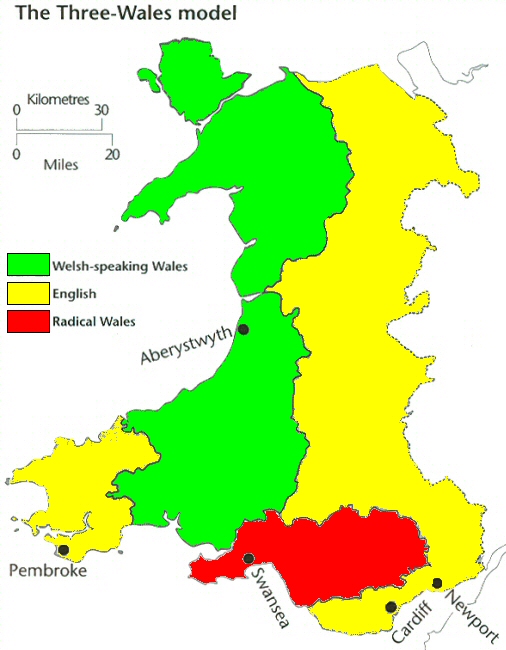
 Welsh is one of the Celtic languages
still spoken. Welsh is an Indo-European language and so has much of the deep
structure of its grammar shared with other Indo-European languages, as well as
much vocabulary cognate with that of other members of the family - including
English. Welsh is less closely related to English than are languages like
French and German and the Scandinavian languages. Its immediate decent is from
the Brythonic language or languages of Roman Britain. The publication of the
Bible in Welsh in 1588 established a standard of language which governs the
subsequent development of Late Modern Welsh, essentially unchanged as far as
the present century. Over the twentieth century the total number of speakers of
Welsh has remained pretty much constant in the face of a sharp rise in the
population.
Welsh is one of the Celtic languages
still spoken. Welsh is an Indo-European language and so has much of the deep
structure of its grammar shared with other Indo-European languages, as well as
much vocabulary cognate with that of other members of the family - including
English. Welsh is less closely related to English than are languages like
French and German and the Scandinavian languages. Its immediate decent is from
the Brythonic language or languages of Roman Britain. The publication of the
Bible in Welsh in 1588 established a standard of language which governs the
subsequent development of Late Modern Welsh, essentially unchanged as far as
the present century. Over the twentieth century the total number of speakers of
Welsh has remained pretty much constant in the face of a sharp rise in the
population.
Estimates suggest that 20% of the population over the age
of three in private households are able to speak Welsh. In much of the rural
north and west, Welsh remains the first language. Welsh is widely used for
official purposes, and is treated equally with English in the work of the
Assembly. It is quite extensively used in broadcasting, and most road signs are
bilingual. Welsh-medium education in schools is encouraged. Since September
2000, Welsh has been taught - as a first or second language - to all pupils
between the ages of 5 and 16, and other subjects are taught in Welsh to primary
and secondary school children in about 500 schools in Wales. The National Assembly is
responsible for supporting Welsh culture and developing greater use of the Welsh
language. The Welsh Language Act 1993 set the principle that, in public business
and in the administration of justice in Wales, Welsh and English should have
equal treatment.
The Welsh Music

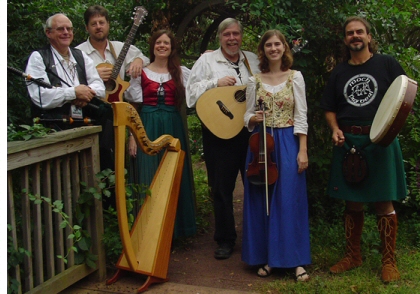

 However Wales is a part of the United Kingdom, it is a culturally distinct
Celtic country. Its traditional music is related to the Celtic music of
countries such as Ireland and Scotland. Together with this Welsh folk music has
distinctive instrumentation and song types. Modern Welsh folk musicians have
sometimes had to reconstruct traditions which had been suppressed or forgotten,
as well as compete with imported and indigenous rock and pop trends.
However Wales is a part of the United Kingdom, it is a culturally distinct
Celtic country. Its traditional music is related to the Celtic music of
countries such as Ireland and Scotland. Together with this Welsh folk music has
distinctive instrumentation and song types. Modern Welsh folk musicians have
sometimes had to reconstruct traditions which had been suppressed or forgotten,
as well as compete with imported and indigenous rock and pop trends.
Scholars are not clear when Welsh music, as a national music, began. There are references to music sung in Wales in the 6th C. writings of the monk Gildas when he criticized the Welsh Bards for singing court "praise-songs" instead of religious songs. This is also the earliest reference to Welsh Bards. The music described by Gildas was music of the court. The first description of music of the common man appeares in in the writings of Giraldus Cambrensis in the 12
c. Gelardus also mentions ox driving songs, a type that was in use in Glamorgan until the end of the 19
c. The earliest surviving collection of secular music is from the "Musica neu Beroriaeth" a manuscript compiled by the harper Robert ap Huw (1580-1665). These pieces, many of which may date from as early as the 13th
c. are for a horse-hair or gut strung harp, played with the fingernails. It is most likely the earliest surviving example of European Harp music.
The earliest Welsh dance tunes that are marked as such, are found in a book entitled Playford's Dancing Master, and date from 1665 to 1718. There are a few others tunes found in a collection that scholars refer to as the London dance books. These, are the only ones prior to John Parry's collection of 1742.
(In comparison English dance music is traceable step by step, from the 13th century onward with examples of actual written notes.)
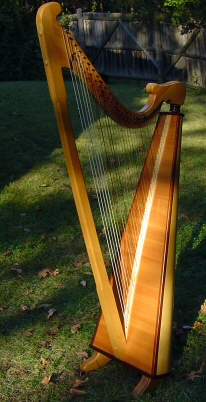 In the Welsh laws of the 10th c. which have come down to us in 12th
c. manuscripts, three instruments are mentioned as used in the courts, the
harp, the crwth and the pibgorn. The harp "telyn" is the best known of Welsh Musical instruments, although it is also to be found among the Scots and Irish, as well as the Anglo-Saxons. Wales, however retained it for a longer period, and probably today the harp is more frequently played there than elsewhere. Early Welsh harps were small and are mentioned as early as the 10th
c. According to Welsh law the harp was one of the three indispensible possessions of a freeman. Accoeding to Marcuse, they were originally supplied with horsehair strings but gut was the rule by the 14th c. Double rowed chromatic harps were developed by the 16 c. throughout Europe. The
triple harp
(with three rows of strings), used nowadays by
Welsh harpists and associated with Welsh harping
did not make an appearance until the 17th c.
In the Welsh laws of the 10th c. which have come down to us in 12th
c. manuscripts, three instruments are mentioned as used in the courts, the
harp, the crwth and the pibgorn. The harp "telyn" is the best known of Welsh Musical instruments, although it is also to be found among the Scots and Irish, as well as the Anglo-Saxons. Wales, however retained it for a longer period, and probably today the harp is more frequently played there than elsewhere. Early Welsh harps were small and are mentioned as early as the 10th
c. According to Welsh law the harp was one of the three indispensible possessions of a freeman. Accoeding to Marcuse, they were originally supplied with horsehair strings but gut was the rule by the 14th c. Double rowed chromatic harps were developed by the 16 c. throughout Europe. The
triple harp
(with three rows of strings), used nowadays by
Welsh harpists and associated with Welsh harping
did not make an appearance until the 17th c.
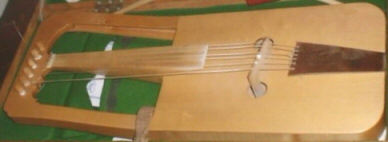 The other musical instruments of Wales were much the same as those in use in England, Ireland, and Scotland. There was, however, one exception, the
crwth, a stringed instrument that started out being plucked and was later bowed. Sibyl Marcuse in her work, A Survey of Musical Instruments, puts the Crwth in the classification of post-Medieval Lyres. Its English name by 1310 was "Crouth",
The other musical instruments of Wales were much the same as those in use in England, Ireland, and Scotland. There was, however, one exception, the
crwth, a stringed instrument that started out being plucked and was later bowed. Sibyl Marcuse in her work, A Survey of Musical Instruments, puts the Crwth in the classification of post-Medieval Lyres. Its English name by 1310 was "Crouth",
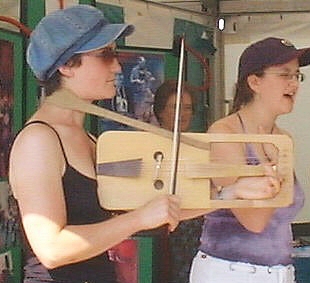 and "Crowd" by the 16th century. She cites the case of a John Hogan who was reprimanded in 1537 for "singing lewd ballads with a crowd or fyddyll". According to Marcuse, by the Middle Ages it was known as a "Chorus", its Latinized form. In the 12th
c. Gerald of Wales (Girardus Cambrensis) wrote that the "Chorus" was in general use in Wales and Scotland. Aimeri de Peyrac says in the 14th
c. that the "Chorus" had two pairs of strings
tuned a fourth apart. After the 16th c. the instrument is no longer mentioned. It was "rediscovered" in the 18th
c. when a few people in Wales were found who still played it. According to Marcuse, the few examples
and "Crowd" by the 16th century. She cites the case of a John Hogan who was reprimanded in 1537 for "singing lewd ballads with a crowd or fyddyll". According to Marcuse, by the Middle Ages it was known as a "Chorus", its Latinized form. In the 12th
c. Gerald of Wales (Girardus Cambrensis) wrote that the "Chorus" was in general use in Wales and Scotland. Aimeri de Peyrac says in the 14th
c. that the "Chorus" had two pairs of strings
tuned a fourth apart. After the 16th c. the instrument is no longer mentioned. It was "rediscovered" in the 18th
c. when a few people in Wales were found who still played it. According to Marcuse, the few examples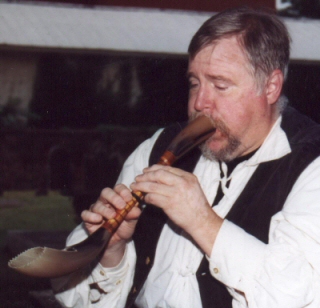 that have been preserved from the 18th
c. "...have an oblong body with flat belly and back, straight sides, closed at the top. Handholes separated by a central fingerboard and 2 circular holes cut in the belly; two off-board strings have been added to the 4 bowed ones, all of which are secured by rear pegs in the top." By the 18th
c. the Crwth was held almost like a violin, but that is considered to be because of the violin's influence. Despite efforts to revive the Crwth it was extinct by the 19th c. One that was still being played in the early 19th century was played with a bow and was described as being "harsh and disagreeable". The rest of the Welsh instruments, so far as we know, were the
pibgorn (on the
right)
or hornpipe, the pibgod or bagpipe, the bugle , and the tabret or tabor, a small drum.
that have been preserved from the 18th
c. "...have an oblong body with flat belly and back, straight sides, closed at the top. Handholes separated by a central fingerboard and 2 circular holes cut in the belly; two off-board strings have been added to the 4 bowed ones, all of which are secured by rear pegs in the top." By the 18th
c. the Crwth was held almost like a violin, but that is considered to be because of the violin's influence. Despite efforts to revive the Crwth it was extinct by the 19th c. One that was still being played in the early 19th century was played with a bow and was described as being "harsh and disagreeable". The rest of the Welsh instruments, so far as we know, were the
pibgorn (on the
right)
or hornpipe, the pibgod or bagpipe, the bugle , and the tabret or tabor, a small drum.
Welsh musicians have, from early times, held musical meetings at which harpers and other performers from different parts of the country played in competitions. The modern survival of these meetings is the Eisteddfod an important feature of musical life in Wales today.
The Leek and the Daffodil
 The leek is known to have been displayed as a Welsh emblem in 1536 and
in Henry V, Shakespeare acknowledged this as an ancient custom. One legend
tells of a battle between the Welsh and the Saxons fought in a field of leeks.
At some time in the past, the leek was an important part of the diet but it is
not commonly eaten today. It is delicious when part of the traditional leek and
potato soup.
The leek is known to have been displayed as a Welsh emblem in 1536 and
in Henry V, Shakespeare acknowledged this as an ancient custom. One legend
tells of a battle between the Welsh and the Saxons fought in a field of leeks.
At some time in the past, the leek was an important part of the diet but it is
not commonly eaten today. It is delicious when part of the traditional leek and
potato soup.
The daffodil has no such claim to literary and historical
distinction. It has become the more favoured emblem of late, however, since
some people find that it makes a more attractive buttonhole on St. David's day.
Daffodils and new-born lambs herald the summer in Wales.
The Wales Tourist Board produced the following notes:
"On the evidence of Shakespeare, the leek was the recognised
emblem of his day, and there is written evidence that it became the Welsh
emblem considerably earlier. Entries in the household accounts of the Tudor
Kings include payments for leeks worn by the household guards on St.
David's Day. According to a legend, the leek is linked to St. David
because he ordered his soldiers to wear them on their helmets when they fought
a victorious battle against the pagan Saxons in a field full of leeks.
It was more likely, however, that the leek was linked with St. David and
adopted as a national symbol because of its importance to the national diet in
days of old, particularly in Lent."
sources:
National Statistics, UK 2002, The Official
Yearbook of Great Britain and Northern Ireland
Wikipedia,
St David's Day,
Welsh Music
Moch Pryderi, Celtic
Music of Wales, Brittany and other Celtic Nations
Wales Tourist Board
credits:
1. The Welsh Language:
extracted from The Official Yearbook of GB and NI
© Crown Copyright 2001, under PSI
licence
2.
Celtic Music of Wales, Brittany
and other Celtic Nations
©
Moch Pryderi 2006


 St.
David’s Day (1 March) is the national day of Wales. St. David (cc. 520-588), the
patron saint of Wales, was the founder and first abbot-bishop of Menevia, now
St. David’s in Dyfed, South Wales.
St.
David’s Day (1 March) is the national day of Wales. St. David (cc. 520-588), the
patron saint of Wales, was the founder and first abbot-bishop of Menevia, now
St. David’s in Dyfed, South Wales.  Many Welsh people wear one or both of the national emblems of Wales on their lapel to celebrate Saint David: the daffodil or the leek (Saint David's personal symbol) on this day. Males usually wear leeks or daffodils. The younger girls usually wear their Welsh costumes to school. This costume consists of a long woollen skirt, white blouse, woollen shawl and a Welsh hat. The Flag of Saint David
(a gold field with a black cross
or a black field with a gold cross) is most commonly seen flying on Saint David's Day.
Many Welsh people wear one or both of the national emblems of Wales on their lapel to celebrate Saint David: the daffodil or the leek (Saint David's personal symbol) on this day. Males usually wear leeks or daffodils. The younger girls usually wear their Welsh costumes to school. This costume consists of a long woollen skirt, white blouse, woollen shawl and a Welsh hat. The Flag of Saint David
(a gold field with a black cross
or a black field with a gold cross) is most commonly seen flying on Saint David's Day.


 In the Welsh laws of the 10th c. which have come down to us in 12th
c. manuscripts, three instruments are mentioned as used in the courts, the
harp, the crwth and the pibgorn. The harp "telyn" is the best known of Welsh Musical instruments, although it is also to be found among the Scots and Irish, as well as the Anglo-Saxons. Wales, however retained it for a longer period, and probably today the harp is more frequently played there than elsewhere. Early Welsh harps were small and are mentioned as early as the 10th
c. According to Welsh law the harp was one of the three indispensible possessions of a freeman. Accoeding to Marcuse, they were originally supplied with horsehair strings but gut was the rule by the 14th c. Double rowed chromatic harps were developed by the 16 c. throughout Europe. The
triple harp
(with three rows of strings), used nowadays by
Welsh harpists and associated with Welsh harping
did not make an appearance until the 17th c.
In the Welsh laws of the 10th c. which have come down to us in 12th
c. manuscripts, three instruments are mentioned as used in the courts, the
harp, the crwth and the pibgorn. The harp "telyn" is the best known of Welsh Musical instruments, although it is also to be found among the Scots and Irish, as well as the Anglo-Saxons. Wales, however retained it for a longer period, and probably today the harp is more frequently played there than elsewhere. Early Welsh harps were small and are mentioned as early as the 10th
c. According to Welsh law the harp was one of the three indispensible possessions of a freeman. Accoeding to Marcuse, they were originally supplied with horsehair strings but gut was the rule by the 14th c. Double rowed chromatic harps were developed by the 16 c. throughout Europe. The
triple harp
(with three rows of strings), used nowadays by
Welsh harpists and associated with Welsh harping
did not make an appearance until the 17th c. The other musical instruments of Wales were much the same as those in use in England, Ireland, and Scotland. There was, however, one exception, the
crwth, a stringed instrument that started out being plucked and was later bowed. Sibyl Marcuse in her work, A Survey of Musical Instruments, puts the Crwth in the classification of post-Medieval Lyres. Its English name by 1310 was "Crouth",
The other musical instruments of Wales were much the same as those in use in England, Ireland, and Scotland. There was, however, one exception, the
crwth, a stringed instrument that started out being plucked and was later bowed. Sibyl Marcuse in her work, A Survey of Musical Instruments, puts the Crwth in the classification of post-Medieval Lyres. Its English name by 1310 was "Crouth",
 and "Crowd" by the 16th century. She cites the case of a John Hogan who was reprimanded in 1537 for "singing lewd ballads with a crowd or fyddyll". According to Marcuse, by the Middle Ages it was known as a "Chorus", its Latinized form. In the 12th
c. Gerald of Wales (Girardus Cambrensis) wrote that the "Chorus" was in general use in Wales and Scotland. Aimeri de Peyrac says in the 14th
c. that the "Chorus" had two pairs of strings
tuned a fourth apart. After the 16th c. the instrument is no longer mentioned. It was "rediscovered" in the 18th
c. when a few people in Wales were found who still played it. According to Marcuse, the few examples
and "Crowd" by the 16th century. She cites the case of a John Hogan who was reprimanded in 1537 for "singing lewd ballads with a crowd or fyddyll". According to Marcuse, by the Middle Ages it was known as a "Chorus", its Latinized form. In the 12th
c. Gerald of Wales (Girardus Cambrensis) wrote that the "Chorus" was in general use in Wales and Scotland. Aimeri de Peyrac says in the 14th
c. that the "Chorus" had two pairs of strings
tuned a fourth apart. After the 16th c. the instrument is no longer mentioned. It was "rediscovered" in the 18th
c. when a few people in Wales were found who still played it. According to Marcuse, the few examples that have been preserved from the 18th
c. "...have an oblong body with flat belly and back, straight sides, closed at the top. Handholes separated by a central fingerboard and 2 circular holes cut in the belly; two off-board strings have been added to the 4 bowed ones, all of which are secured by rear pegs in the top." By the 18th
c. the Crwth was held almost like a violin, but that is considered to be because of the violin's influence. Despite efforts to revive the Crwth it was extinct by the 19th c. One that was still being played in the early 19th century was played with a bow and was described as being "harsh and disagreeable". The rest of the Welsh instruments, so far as we know, were the
that have been preserved from the 18th
c. "...have an oblong body with flat belly and back, straight sides, closed at the top. Handholes separated by a central fingerboard and 2 circular holes cut in the belly; two off-board strings have been added to the 4 bowed ones, all of which are secured by rear pegs in the top." By the 18th
c. the Crwth was held almost like a violin, but that is considered to be because of the violin's influence. Despite efforts to revive the Crwth it was extinct by the 19th c. One that was still being played in the early 19th century was played with a bow and was described as being "harsh and disagreeable". The rest of the Welsh instruments, so far as we know, were the
 The leek is known to have been displayed as a Welsh emblem in 1536 and
in Henry V, Shakespeare acknowledged this as an ancient custom. One legend
tells of a battle between the Welsh and the Saxons fought in a field of leeks.
At some time in the past, the leek was an important part of the diet but it is
not commonly eaten today. It is delicious when part of the traditional leek and
potato soup.
The leek is known to have been displayed as a Welsh emblem in 1536 and
in Henry V, Shakespeare acknowledged this as an ancient custom. One legend
tells of a battle between the Welsh and the Saxons fought in a field of leeks.
At some time in the past, the leek was an important part of the diet but it is
not commonly eaten today. It is delicious when part of the traditional leek and
potato soup.